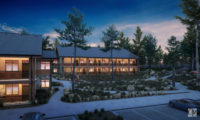Getting into a construction groove at the Grove at Grand Bay in Miami was not easy, due to the drastic and sundry twists of the 21-story towers. Getting the gravity- defying concrete structures to twist without falling over also was tricky.
The two residential towers in Coconut Grove were angled and eccentrically shaped by Bjarke Ingels Group, with Nichols, Brosch, Wurst, Wolfe + Associates, to optimize views of Biscayne Bay.
Set for completion in October, the buildings face each other like a couple dancing the twist. Each has rounded exposed perimeter columns that slant in two planes, but the tilts are different from floor to floor, column line to column line and building to building. Floor plates are rotated by about 3˚ in plan relative to the floor below until the upper five floors, where columns are vertical, but each tower has a different footprint.
For the general contractor of the $144-million project, the hardest part was making sure column slopes—ranging from 10˚ to 38˚—were "perfect," says Bud Phillips, project executive for Facchina Construction. Form adjustments had to be made even if a slope was off by only 1˚. Some forms were adjusted 10 or 15 times.
The foremost structural challenge was to find a cost-effective solution that did not gobble up saleable space to resist the large torsional forces caused by the twists, says Vincent J. DeSimone, founder and chairman of DeSimone Consulting Engineers. Perimeter column lines slant in the same general direction. That creates the torsion that, left unrestrained, would cause the building to come spinning down, adds DeSimone.
Restraining the forces made the buildings "very complex," he says. Consequently, the structure alone costs 20% more than a standard building.
The primary structure of each tower is a central core and perimeter columns, connected by post-tensioned concrete floor slabs that cantilever 10 ft to 16 ft beyond the window wall to form balconies. There are no interior column lines. Core shear walls are the only consistently vertical structural elements.
The structural engineer ruled out using conventionally reinforced concrete core walls because the magnitude of the combined horizontal shear force from the building self-weight and the lateral wind loads required walls as thick as 6 ft.
Instead, DeSimone designed a composite shear-wall and link-beam system. The action between a steel plate set in concrete—like a slice of ham between slabs of bread—allowed 30-in.-thick shear walls made of high-strength concrete.
The approach translated to 850 sq ft per floor of more saleable floor space, compared to 6-ft-thick walls. Based on an average condominium price of $1,200 per sq ft, the system allowed a sales increase of $19.4 million, says DeSimone. Discounting the $6-million premium for composite core walls, not even including savings in conventional rebar replaced by the steel plates, DeSimone figures the developer, Terra Group, had a net gain of $13.4 million over the 6-ft-thick walls.
In the system, a column's own weight is taken by the foundations. Horizontal components of axial loads travel through slabs to the core, which resists the twist.









Post a comment to this article
Report Abusive Comment